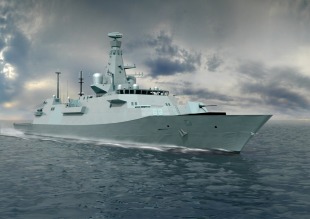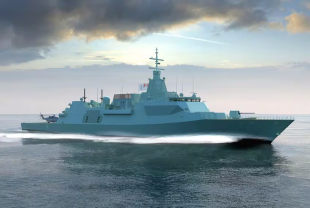Надводный боевой корабль одного класса
Основная информация
Future Surface Combatant
The Global Combat Ship started development under the original Future Surface Combatant (FSC) programme intended to replace the Royal Navy's Type 22 and Type 23 frigates. Planning for a replacement escort vessel started in 1998 with the ordering of a research vessel, RV Triton, to study whether a trimaran design was practical for such a large and complex vessel. However, more conventional designs were ultimately preferred. In March 2005, plans were released for a two-class solution, a cheaper «Medium Sized Vessel Derivative» entering service in 2016–19 and a more capable «Versatile Surface Combatant» entering service around 2023.
In early 2006 the MoD started a Sustained Surface Combatant Capability (S2C2) programme which explored synergies between the FSC and other needs, for minesweepers, patrol ships and survey ships. By early 2007 this had crystallized into the three requirements; C1, C2 and C3. The C1 was to be an anti-submarine warfare task group-enabled platform and would displace around 6,000 tonnes. C2 was to be a more general purpose platform displacing somewhere in the region of 4–5,000 tonnes, and C3 was to be a Global Corvette to replace a larger number of smaller vessels in service, such as minesweepers, patrol and survey ships. The Global Corvette was to displace around 2–3,000 tonnes.
The C3 concept began in early 2004 when the MoD issued a Request for Information (RFI) for a smaller class of ship known as the Global Corvette. Low running costs and the ability to operate forward in shallow, coastal areas where larger ships cannot, were both important. BAE Systems, VT Group, Thales and Rolls-Royce responded in autumn 2004 with concepts ranging from a well-equipped Offshore Patrol Vessel (OPV) of 1,500 tonnes to an advanced and very capable «corvette» of 3,000 tonnes, along the lines of the USN's Littoral Combat Ship programme (LCS).
The FSC concept was brought forward in the 2008 budget, at the expense of options for two Type 45 destroyers not being taken up (ships 7 and 8). In 2009 BAE Systems received a contract to design the C1 and C2 frigates with a planned 25-year life. A total of 18 vessels (10 C1 and 8 C2) were planned to enter service from 2020, at a pace of roughly one per year. In early 2010 the C3 variant was dropped in favour of the Mine Countermeasures, Hydrography and Patrol Capability (MHPC) programme.
Global Combat Ship
Official mention of the Future Surface Combatant had all but disappeared by 2010, and on 25 March of that year BAE Systems were given a four-year, £127 million contract by the Ministry of Defence to fully design a new class of warship, the «Global Combat Ship», previously C1 of the FSC. Expectations at the time were for the first ship to be «in service» by 2021. The October 2010 Strategic Defence and Security Review (SDSR) reaffirmed the government's commitment to the Global Combat Ship, saying; «As soon as possible after 2020 the Type 23 will be replaced by Type 26 frigates, designed to be easily adapted to change roles and capabilities depending on the strategic circumstances». As part of the defence review it was also announced that the remaining Type 22 frigates would be decommissioned without replacement, reducing the Royal Navy's escort fleet from 23 destroyers and frigates to 19 (6 Type 45 destroyers and 13 Type 23 frigates).
BAE Systems' original working baseline for the Global Combat Ship design was a vessel 141 metres long with a displacement of 6,850 tonnes and a range of 7,000 nautical miles at 18 knots. However, on 30 November 2010 it was reported that the specifications had been pared down, in effort to reduce the cost from £500M to £250–350M per ship. Subsequently, new specification details began to emerge of a smaller 5,400 tonne ship emphasising flexibility and modularity.
Unlike the FSC, the Global Combat Ship has only one hull design. However like the Franco-Italian family of FREMM multipurpose frigates, three versions are proposed for export: a design optimised for anti-submarine warfare (ASW), an anti-aircraft warfare (AAW) variant, and a general purpose (GP) variant.
Although a decision was made in November 2010 to reduce the specifications and capability requirements of the Global Combat Ship design, BAE Systems' design concepts by 2014 had returned to their original working baseline of a large 6,900 tonne warship. In February 2015, the MoD and BAE Systems signed a £859 million contract to continue development and progress towards manufacturing. A 12-month demonstration phase began on 1 April 2015 and, after a 12-month extension in March 2016, was scheduled to be completed in June 2017.
- Комментарии
 ru
ru en
en uk
uk



 Королевский канадский военно-морской флот
Королевский канадский военно-морской флот Королевский австралийский военно-морской флот
Королевский австралийский военно-морской флот Королевский военно-морской флот Великобритании
Королевский военно-морской флот Великобритании